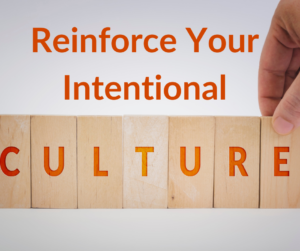 Once you’ve identified your culture (hopefully with three words that are easy to communicate), you need to reinforce it on a regular basis. You can use your three words to go back and fine tune the final version of your mission, vision, and values statements. Just make sure that the values expressed in those statements are “lived” and felt every day in your company. One person moving against the culture of your organization will cause problems, and, if they are allowed to continue to do so, your aligned people will leave because the organization is not living its intentional culture.
Once you’ve identified your culture (hopefully with three words that are easy to communicate), you need to reinforce it on a regular basis. You can use your three words to go back and fine tune the final version of your mission, vision, and values statements. Just make sure that the values expressed in those statements are “lived” and felt every day in your company. One person moving against the culture of your organization will cause problems, and, if they are allowed to continue to do so, your aligned people will leave because the organization is not living its intentional culture.
So, what employee rewards programs do you have to honor those who live your culture in their work? For sales, it’s relatively easy: if they sell more, their commission or bonus pay should reflect that. For internal employees, rewards (such as employee of the month or other recognition awards) should reflect very specific examples of culture success. And, if you’re building a team-based culture, recognition should be based on the performance of the whole team, not just an individual.
All of your processes and systems need to stay in alignment with your culture. If your culture exists to treat employees and customers in a humble, smart, and hungry way, for instance, do your processes reflect this? Are there things you are doing that prevent systems from conforming to your culture? Examine how things run in your organization and listen to what your employees and customers have to tell you. If you hear that something is out of alignment from more than one person, chances are they’re right. In a “smart” culture, you would encourage them to also have a solution, rather than waiting for you or a manager to fix it for them. Do your employees feel enabled to make something right for a customer? Is that in alignment with what you say your values and culture are?
Think of your company’s intentional culture as a highway that has just been paved: The road signs are clear. There is no traffic congestion. Everyone knows which side of the road to drive on. All drivers know which direction they’re headed and how to recognize when they get where they’re going. Unintentional culture is more like driving on a dirt road, with no signs, and in the wrong kind of vehicle. What are the odds these drivers know where they’re going and can actually get there? Is your organization’s culture the paved road or the dirt road? Create the road you want, or it will be created for you.
Excerpted from my book, “Putting Together the Entrepreneurial Puzzle: The Ten Pieces Every Business Needs to Succeed.” Available here on Amazon.
